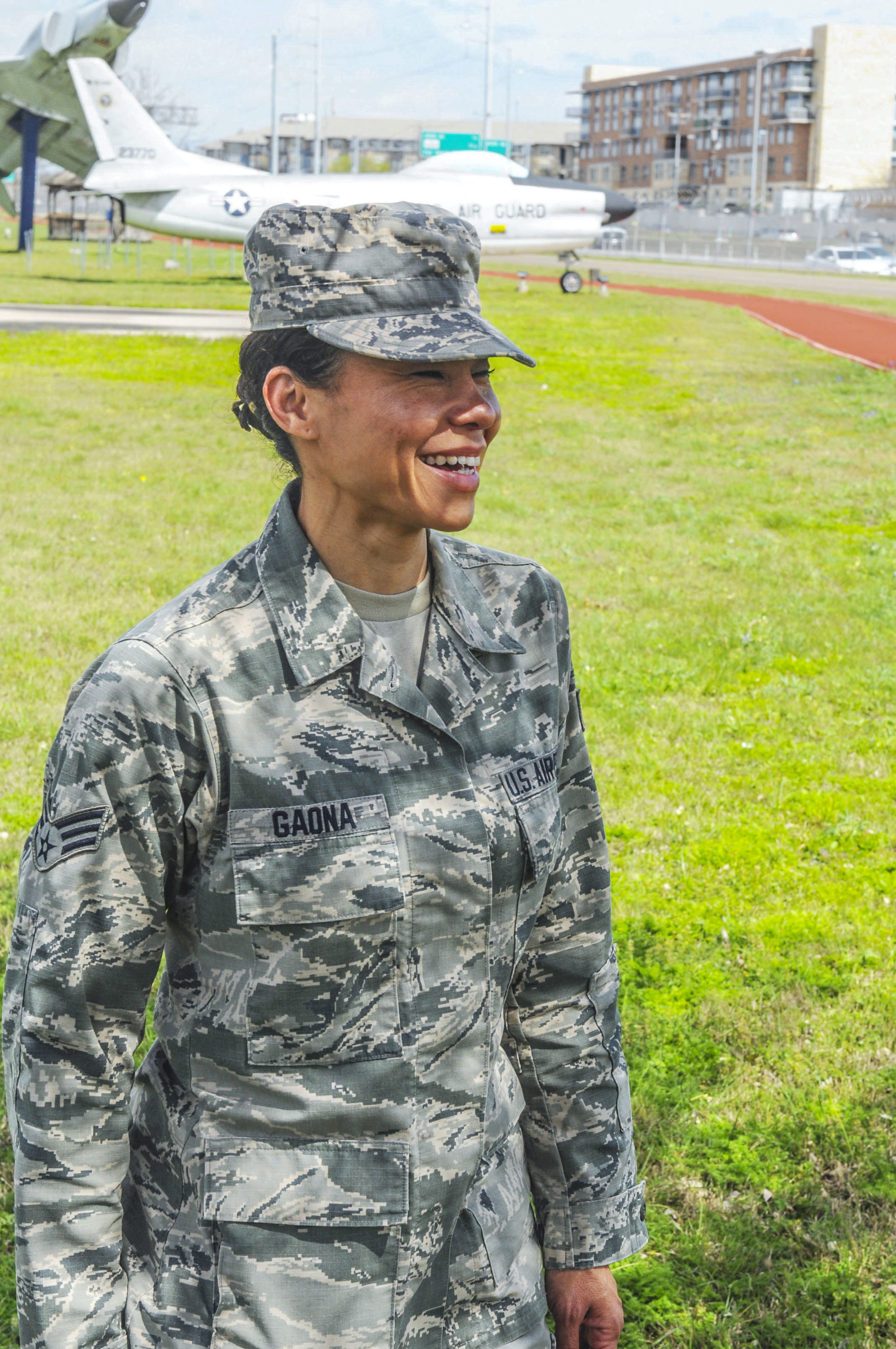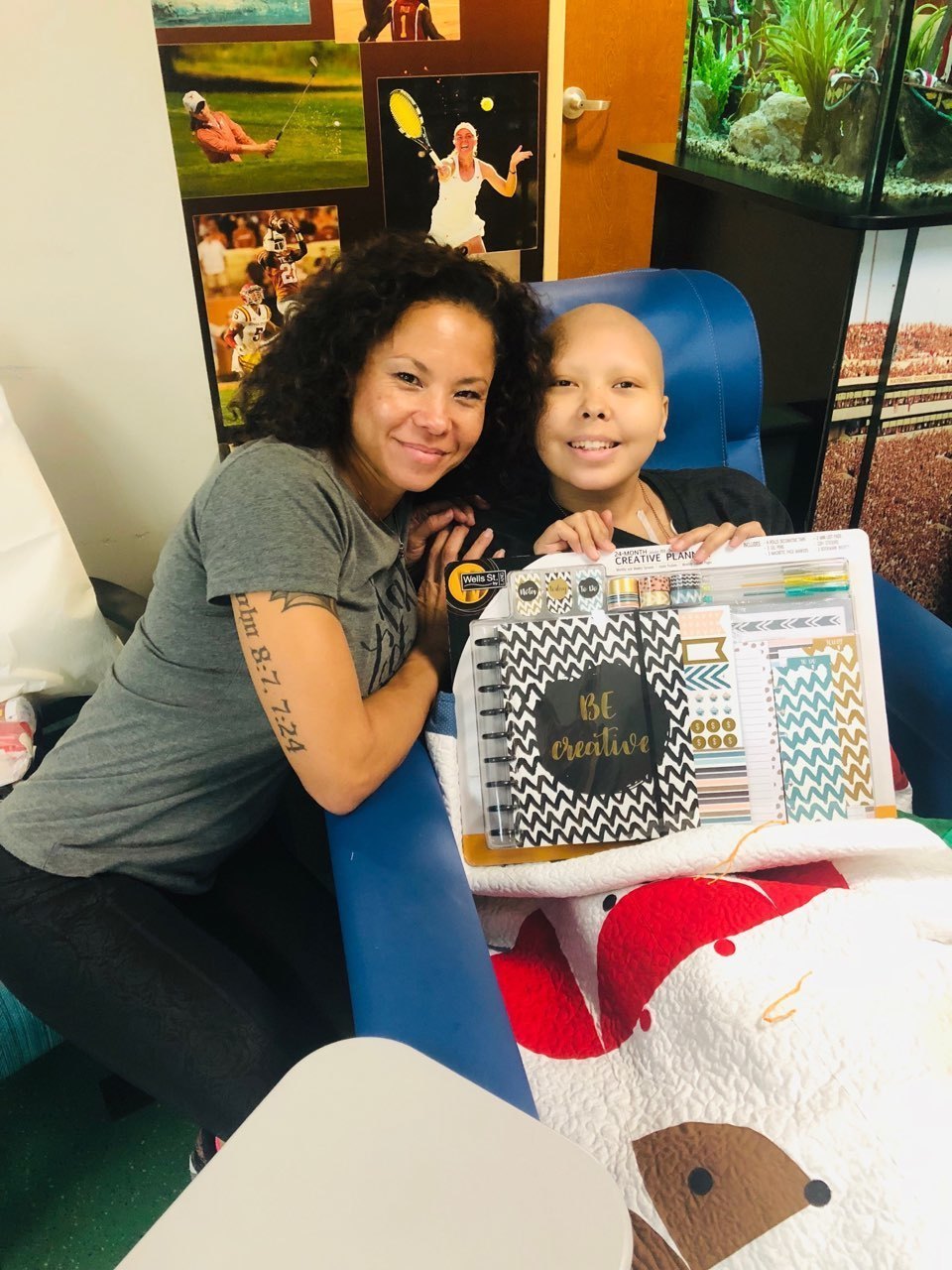Story and Photos by Capt. Nadine Wiley De Moura, Joint Counter Drug Taskforce/ 100th MPAD
AUSTIN, Texas— Frozen in what one can only describe as a nightmare, Staff Sgt. Kimberly Gaona clenched Kiyana, her 13 year-old daughter’s hand in a hospital room and held back tears as she faced the harrowing reality that no parent wishes to face.
 Staff Sgt. Kimberly Gaona, a Texas National Guard Joint Counterdrug Task Force Ground Reconnaisance Detachment operator and a medic with the 149th Medical Group, 6th Chemical Biological Radiological Nuclear and Explosives Enhanced Response Force Package, 149th Attack Wing, Texas Air National Guard stands in front of an Air Guard aircraft at Camp Mabry, Texas.
Staff Sgt. Kimberly Gaona, a Texas National Guard Joint Counterdrug Task Force Ground Reconnaisance Detachment operator and a medic with the 149th Medical Group, 6th Chemical Biological Radiological Nuclear and Explosives Enhanced Response Force Package, 149th Attack Wing, Texas Air National Guard stands in front of an Air Guard aircraft at Camp Mabry, Texas.
The doctor and a nurse entered the room and delivered the news. “She has cancer.”
“It was like a freight train,” said Gaona. “It will just stop you in your tracks when you hear those words about your kid.”
Sitting behind her daughter, Gaona, a Texas National Guard Joint Counterdrug Task Force Ground Reconnaissance Detachment operator and a medic with the 149th Medical Group, 6th Chemical Biological Radiological Nuclear and Explosives Enhanced Response Force Package, 149th Airlift Wing, Texas Air National Guard, wouldn’t let her daughter see the emotion in her face.
Instead, she collected herself, stepped out of the hospital room and notified her friend and mentor in the Counterdrug program of the news.
Gaona, 43, a divorced and single mother of four, also notified Kiyana’s father of the news.
“Acute Myeloid Leukemia is a cancer of the blood, is produced in the bone, which is everywhere in the body,” said Gaona. “So that was scary to hear about how to treat it if it is everywhere.
“We were fortunate, only 20 percent of her body was consumed by cancer. She did great the first three months--the last chemo-therapy treatment was brutal.”
Kiyana, who turned 14 while being treated for AML in the hospital, fought for her life as she underwent several allergic reactions, fevers and pneumonia from the transfusions.
“She didn’t see me cry and I did not let her,” said Gaona. “She wanted to understand, so from a medical standpoint I helped her understand what was happening and it helped her.”
Gaona used her medical training from the Airforce to decipher information about her daughter’s cancer and follow along with the charts.
“It was definitely a different world in oncology, I could hear the treatment plan and the x-rays every day,” said Gaona. “When it wasn’t good, I wouldn’t tell her, but it was peace of mind from my medical training to know what was going on.”
As Kiyana entered remission, Gaona reflected on her ability to remain resilient throughout such a distressful experience.
“I don’t know that I have had to use that level of fortitude before--someone had to do it,” said Gaona. “If you are strong for people who are not, it gives them hope and mentally I don’t think she ever thought about not fighting even though there were days where she just felt horrible.”
Kiyana, who trained and ruck marched with her mother just days before her cancer diagnosis, drew on her mother’s grit to overcome her circumstances as she battled the treatment. Even at her lowest moments, on an incubator, she refused to be sedated throughout the process.
 Staff Sgt. Kimberly Goana smiles next to her daughter, Kiyana. Gaona used her life experiences and military training to remain resilient during her daughter's fight against cancer. Texas National Guard Joint Counterdrug Task Force members came together to gift Kiyana with a prayer blanket made by a local church group, the Piece Makers.
Staff Sgt. Kimberly Goana smiles next to her daughter, Kiyana. Gaona used her life experiences and military training to remain resilient during her daughter's fight against cancer. Texas National Guard Joint Counterdrug Task Force members came together to gift Kiyana with a prayer blanket made by a local church group, the Piece Makers.
“We don’t know when to stop,” said Gaona. “If you know how to stop or even think it, then you will. But if that’s not something in your mindset, then you won’t stop, you’ll just keep going.
“She is strong and driven. She is amazing, brilliant and beautiful.”
Although she said that nothing could have prepared her for this experience, this was not the first time in Gaona’s life that she persevered in the face of adversity.
Gaona, an adoptee, forged a path of defying the odds when she enlisted in the Texas Air National Guard at the cut off age of 39.
Shortly after completing her initial trainings, she became the first female to complete the Texas National Guard Counterdrug Ground Reconnaissance Operators Training Course and work as an operator on a team.
The course is a test of physical and mental exertion, with 4 a.m. wake-ups and grueling workouts. All operators must pass the Army Physical Fitness Test adhering to the male age 17-21 bracket maximum scores, complete a 12-mile ruck march and run five miles in 40 minutes.
“She is an operator and is exactly what I would expect of my team,” said Maj. Robert Cowart, Texas National Guard Ground Reconnaissance officer-in-charge. “We have high standards. Everybody’s character is good, and goes above and beyond. If they don’t, they can’t stay here---Gaona keeps up there with the team.”
Ground Reconnaissance operators are trained to work in stressful and highly sensitive environments employing bucket truck operations, tower climbing, and photography and radio skills to support law enforcement agents on highly sensitive missions.
“We conduct the Operator Training Course because we are looking for resilient professional Soldiers and Airmen who can be trusted in autonomous situations and have the conditioning and trust to make necessary decisions,” said Cowart.
The culminating exercise is a three day land navigation course across several thousand acres, carrying a rucksack with some food, water and a compass.
“I had to do a 72 hour course and find some points in 72 hours and we weren’t allowed to sleep,” said Gaona. “That alone, I think it was a big part of me being able to handle what happened afterwards. I had been doing my job as an operator for six months when Kiyana was diagnosed with cancer.”
Gaona said that the trust and relationships that she built while working on the Counterdrug program were coupled with invaluable support throughout Kiyana’s treatment.
“Change is always happening and those same people who were my support in the Counterdrug program, all of them, were huge supporters and showed up at the hospital within days,” said Gaona.
Gaona continued to work between hospital visits and go into work early in the morning to complete necessary tasks and check up on her Counterdrug teammates.
“She is an endearing person,” said. Master Sgt. Ruben Hernandez, her Counterdrug and Air National Guard mentor. “Every time I was visiting her we would focus on Kiyana, then she would immediately ask how the team was. For me, that is a testament to her character--- she is adamant about helping others.”
Hernandez, who also assisted in recruiting Gaona into the Texas Air National Guard, reflected on Gaona as an asset to the Counterdrug team.
 Staff Sgt. Kimberly Goana's training for a national body building competition includes two hours of cardio per day, one hour of weight lifting per day, and six to seven meals to build muscle.
Staff Sgt. Kimberly Goana's training for a national body building competition includes two hours of cardio per day, one hour of weight lifting per day, and six to seven meals to build muscle.
“All of her charm that comes with her attributes, her knowledge of environmental considerations,” said Hernandez. “She offers a unique dichotomy to the team. As far as acclimation to the team, she has done well, she is a 40 plus-year-old mom of four. There is not a whole lot she has been through that she can’t offer or share light on.”
While her daughter’s cancer was the pinnacle of Gaona’s life challenges, there were many others.
“She has had some pretty significant life challenges,” said Hernandez. “She experienced death in the family pretty young, marriage, kids, owning a business and probably more life experiences than any adult woman that I have met in my life.”
Regardless of the hurdles she faced prior to joining the military, Gaona doesn’t back down and never stops giving.
“She didn’t expect any exemptions, she showed and gave it all she got,” said Hernandez. “The biggest impact has been her being an outlier to the small community here--green berets and ranger guys--and proving herself as a female, as a Soldier and a person as a whole.
“She has had a huge impact and changed the dynamics in our community, and just a different respect for how we carry ourselves. It’s a great sense of pride that not only do we have a female working with us but she fell in with the team.”
Despite the hardships that Gaona faced during her lifetime, and more recently, Gaona continues to inspire her family, her military community and now the bodybuilding community.
With her daughter’s improving health, Gaona, true to her creed, will not stop pushing herself to be the best she can be.
For the past eight months, working around appointments, work commitments, and her motherly duties, Gaona has been preparing to compete in a national bodybuilding competition in October.
“She is tough as nails, that’s the best way to describe her,” said Ivan Meraz, Founder of Team Hard Bodies Austin and Gaona’s competition coach. “She is mentally strong. That’s what body building is all about”.
Gaona’s current regime includes two hours of cardio a day, one hour of weights a day, and six to seven meals a day while juggling her personal and professional life.
“The lady shows up, man,” said Meraz, a coach and competitor who has worked in the bodybuilding industry for more than 20 years. “She is a great person, she is very caregiving. She is always asking me how I am doing when she is the one going through the hard time.
“What I love the most about her is that she shows up and she is tough as nails and I have basically done everything I have to build her and she has answered to that. No complaints, no whining, no questions.”

If Gaona wins the first round of the competition she will go on to compete at the national professional level.
“I wanted a challenge after I got through the Ground Reconnaissance Operators Training Course,” said Gaona. “I have to push for something better. Life has taught me that. I don’t want my kids to think mediocre is OK. If you have more to give, give it.”
While pushing through the final week of her preparation for the competition, Gaona’s energy levels plunge as her diet becomes more restrictive and now, she looks to her daughter and her kids for inspiration.
“Look at Kiyana she has no idea what she accomplished last year,” said Gaona. “That kid fought for her life. She has no idea how strong she is. I hope that I was part of what pushed her through.”
All of her children are following after her example. Gaona’s oldest son enlisted in the Army. Her second oldest is at medical school in Ohio and the youngest two are still in high school.
“I tell my kids ‘don’t be a victim. Don’t be a follower. Make your path’,” said Gaona. “Do what you want don’t let anyone tell you can’t do it unless you have tried.”
As for Gaona’s future, in typical Gaona fashion, there is no end in sight.
Along with re-enlisting for another six years, she has enrolled in school to finish her Associate of Science in Nursing and plans to apply for the Interservice Physician Assistant Program at Fort Sam Houston to become a physician assistant.
“Always stay humble, because the world will make you humble,” said Gaona. “Never forget your dreams. You always have to have goals. There is always more.”